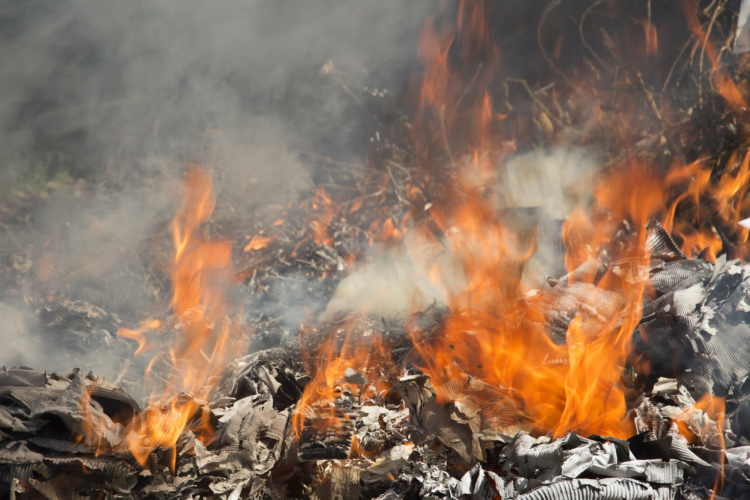Our planet’s resources are finite and dwindling fast as our consumption continues to grow. A recent Nature article found that the material output from human activities has doubled every 20 years, with anthropogenic mass now exceeding our planet’s living biomass. What will happen when such engineered material comes to the end of its engineered life? We must value and preserve the resources used in engineered products and structures for a more sustainable future, and engineers have a key role.
It is estimated that one person dies every 30 seconds in low- and middle- income countries due to the mismanagement of waste and open burning
Discussions around resource, consumption and progress towards a circular economy often overlook matters of health and safety. Yet decommissioning, dismantling and disposal of engineered products and structures at their end of life can be hugely harmful if not carried out responsibly.
This is the focus of the five-year Engineering X Safer End of Engineered Life (SEEL) mission. We raise awareness of the need to plan for end-of-engineered life and to improve the practices involved in disposal and decommissioning of the humanity’s huge diversity of manmade artefacts, from offshore structures and ships to electronic and medical waste.
Our Global Review on Safer End of Engineered Life found widespread use of unsafe management and disposal practices of consumer goods and other engineered products, of which the biggest threat to human safety is open burning of solid waste.
Global practice of open burning of solid waste is a major threat
Half a billion tonnes (24%) of all the municipal solid waste generated on earth is not collected, and a further 27% is mismanaged following collection. Much of this is disposed of by open burning, particularly in low- and middle- income countries which lack safe waste collection and disposal options.
The impact of open burning on health is catastrophic. It damages the health of tens of millions worldwide, and although a lack of data means that the true scale of the problem is unknown, it is estimated that one person dies every 30 seconds in low- and middle- income countries due to the mismanagement of waste and open burning, which can produce pollutants linked to immunological, reproductive, and developmental abnormalities, and which can persist in the environment for a long time.

Despite this, open burning remains very far down the list of global priorities and with governments. One measure of how little attention has been paid to open burning is the lack of knowledge of its impacts on climate change. According to estimates, an equivalent of between 2% and 10% of global CO2 emissions can be attributed to open burning of waste. This is potentially double the impact of aviation but attracts a fraction of the resources. As COP26 draws closer in November and in the wake of the extremely troubling IPCC report, there is an urgent need to better understand the impact open burning has on the health of our planet as well as its people.
Understanding all viewpoints will be vital
Tackling burning of waste will require thoughtful and holistic solutions that also consider the motivations for burning. People, businesses, and governments burn waste for a wide range of reasons and perceived benefits. Burning medical waste can avoid the risk of infection from blood-borne viruses, but it also releases dioxins. Informal e-waste recyclers use burning as a way of extracting precious metals from cables. Any policies to reduce burning must consider the impact on livelihoods and ensure the most vulnerable are protected from unintended consequences.
Solutions are not straightforward and will require partnerships across different sections of society, with government, business, and of course engineers as the managers and designers of many of our systems, all working together. Engineers must design and implement waste management systems that are appropriate to local contexts and develop smaller scale innovations that aid behaviour change, such as providing waste pickers with devices to strip cables as an alternative to burning. Engineers also have a critical role in ensuring that they plan for the end of life of their engineered products and structures, always working with design-for resource minimisation, demanufacture and the circular economy front of mind.
The SEEL mission will continue to raise awareness of open burning and the need for urgent action. We are building communities and partnerships to address this challenge, including at COP26 and COP27 in Africa, and encouraging participation from engineers in the UK and globally to play their part in these efforts.
We must change how we consume the world’s resources to ensure that they are safely and properly disposed of to protect individuals, their communities, and the environment. We urge that tackling of open burning of waste is prioritised in this effort. The current and future cost of inaction is too high to ignore this problem any longer.
Open burning is the topic of the Royal Academy of Engineering Critical Conversation on 15 September that will be broadcast live on LinkedIn and will be available to view after the event on the Academy’s website.
This is the latest in a series of guest blogs from experts involved in the Royal Academy of Engineering’s Engineering X programme, an international collaboration founded with Lloyd’s Register Foundation that aims to bring together some of the world’s leading problem-solvers to address the great challenges of our age.




Project to investigate hybrid approach to titanium manufacturing
What is this a hybrid of? Superplastic forming tends to be performed slowly as otherwise the behaviour is the hot creep that typifies hot...